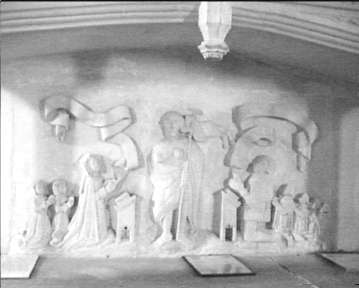![]()

![]()
21. St Peter's Racton

It is easy to drive past this small 12th century church with its typical Sussex bell cote on the nave roof, as you journey up the B2146 on the road leading from Westbourne to Walderton. But that would be a mistake.
Once inside, the ancient trussed wooden rafters of the nave roof are quite striking. High up above the entrance to the chancel can be seen a very large Royal Coat of Arms of George II attached to intricate lattice like wood tracery. There is no chancel screen.
Beyond, the eye is immediately drawn to the impressive 14th century East Window which contains some fine stained glass full of rich colours. The glass, dating from 1918, is a memorial to two brothers. One, Stephen Edmond Fell Christie of the Irish Guards, was killed at Ypres in July 1916, aged 19, whilst the other Basil Robert Francis Christie of the Coldstream Guards was killed at Les Boeufs on the Somme in October 1916 aged 20. The risen Christ is depicted in the centre. On either side the two boys are shown in knightly armour in Arthurian style one bearing a sword and the other a lance. In the outer windows the two regimental badges and mottoes are shown with various angels flying above. This window, plus a very colourful and unusual altar frontal showing a rooster perched on top of a mountain peak displaying all the colours of the rainbow add much to the brightness of the church.

Three fine memorials can be seen in the chancel. To the left of the altar is the painted tomb of Sir George Gunter, who died in 1624, and his wife Ursula. Both are shown kneeling at prayer desks, facing each other and dressed in 17th century costumes. It has recently been restored in mainly blue and green colours. The Gunter family were linked to Racton Manor for several centuries. Another descendant, Colonel George Gunter, helped Charles II escape from Brighton to France after the Battle of Worcester in 1652. It is alleged that the King lodged in the thatched cottage immediately behind the church during his flight.
Alongside is a typical 18th century memorial to Sir Charles Gautier Nicoll K.B. who died in 1733 having "all the qualifications of a compleat and accomplished Gentleman." A marble bust portrays him dressed as a Roman senator. Above are displayed his helmet and gauntlets as well as his coat of arms.
The third and largest memorial, opposite the pulpit, is the canopied white stone table tomb of John Gunter who died in 1557. He gave instructions in his will for the building of the tomb. Carved in the centre is the Risen Christ. On the East side is a man in armour kneeling (presumably John himself), and behind four kneeling sons, John, William, Henry and Arthur. On the West side is a woman in mantle and head dress, presumably one of his three wives, and two kneeling daughters. Carved below are the family crests showing 'three dexter gauntlets argent.' Altogether a fine Elizabethan tomb.
The nave is less spectacular. All the windows, including a 17th century square headed one on the south side, are of plain glass. At the back of the church is a plain 12th century tub shaped font. Red tiles make up the floor of the nave. The lighting is unusual being in the form of six hanging lights shaped like old oil lamps, an interesting way of combining old and new.
All in all a peaceful little church full of charm and history.
written by John Symonds
![]() Return to the September 1998 Features page
Return to the September 1998 Features page
![]() return to Home page and main index
return to Home page and main index
page last updated 27 AUGUST 1998